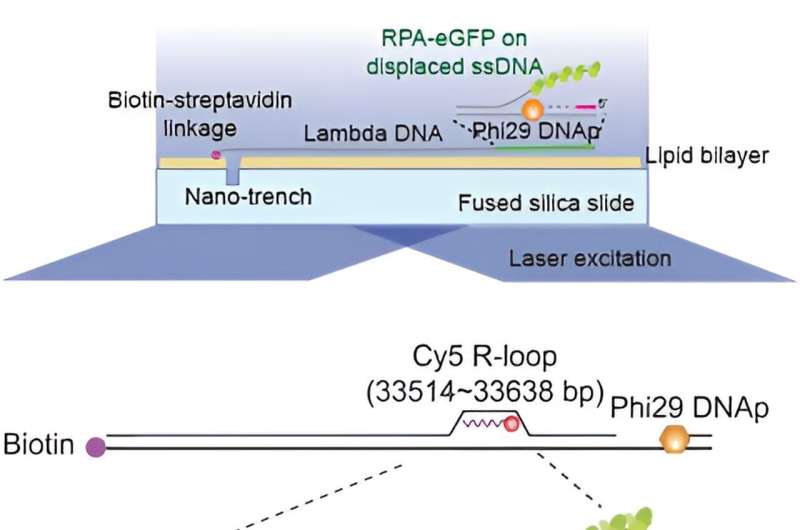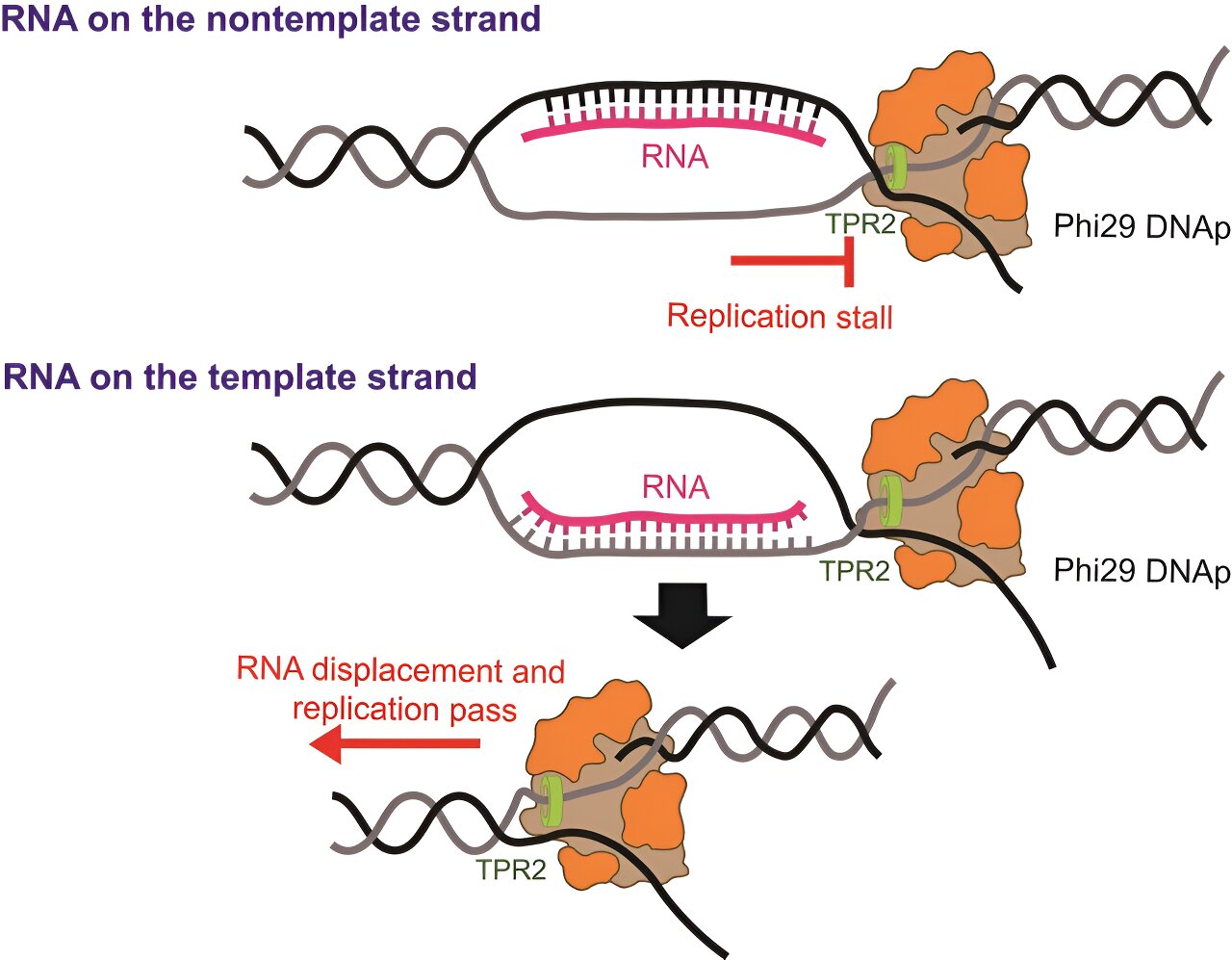Schematic diagram for direct visualization of the collision between Phi29 DNAp and R-loops. credit: Nucleic acid research (2023). doi: 10.1093/nar/gkad1101
A research team led by Professor Ja-Yel Lee at UNIST’s Department of Biological Sciences has made significant progress in the field of molecular biology. their research, published In the magazine Nucleic acid researchsuccessfully imaged the DNA replication process in real time using an innovative “DNA curtain” technique.
This achievement represents the first-ever direct observation of DNA replication and its interactions with R-loops and transcription proteins, shedding new light on long-standing questions in the field.
DNA replication plays a vital role in transmitting genetic information to the next generation. However, it often faces obstacles such as interference caused by the transcription process or collisions with R-loops, which arise from incomplete transcription.
These phenomena, known collectively as “DNA replication stress,” have been associated with various diseases, including cancer, neurological disorders, and aging. Thus, obtaining a comprehensive understanding of the conflicts between replication, transcription, and R-loops is of paramount importance for developing disease prevention and treatment strategies.
To directly image the DNA replication process, the research team used DNA Curtain technology, a single-molecule imaging method. This technique facilitated the direct observation of collisions between DNA replication and transcription, or R-loops. Through their experiments, the team demonstrated that even a single R-loop can hinder DNA replication and induce replication stress, observing a higher degree of blockage when an RNA-DNA hybrid is present on the strand. Change the template.
The team determined that this asymmetry arises from the formation of secondary structure on the non-template strand, which hinders the progression of the Phi29 DNA polymerase. Furthermore, the formation of G-quadruplex structures on single-stranded DNA displaced within the R loop amplifies replication arrest. In addition, the researchers observed collisions between Phi29 DNA polymerase and RNA transcripts synthesized by T7 RNA polymerase, revealing that RNA transcripts cause more frequent pausing due to the presence of T7 RNA polymerase.

(Top) Schematic diagram of the DNA curtain of the Phi29 DNAp repeat. The engineered lambda DNA (I3) is modified with biotin and a Phi29 DNAp replication primer at both ends. In the DNA curtain, Phi29 DNAp assembles DNA from the DNA duplex which unwinds the DNA. RPA–eGFP binds to the non-template displaced strand. RPA-eGFP is fluorescently imaged by TIRFM. (Middle) Schematic of the DNA curtain assay for collision between Phi29 DNAp and the R-loop. (Bottom) Kymographs showing Phi29 DNAp stopping for collision with the R-loop of RD_T. credit: Nucleic acid research (2023). doi: 10.1093/nar/gkad1101
“DNA replication lies at the core of life phenomena, and this study represents the world’s first real-time fluorescence imaging of DNA replication and its interference with transcription and R-loops,” Professor Lee noted. “It provides a direct answer to a long-standing problem in molecular biology known as the ‘copy-replication collision.’” He added: “Going forward, we aim to apply this pioneering technology to further research on human DNA replication and transcription.” ”
Soobin Kim, the first author of this study and a Ph.D. The researcher stressed the importance of the findings, especially regarding R-loops, which are actively studied around the world as potential causes of various diseases, including cancer and neurological disorders such as leukemia. The study is expected to make a significant contribution to the development of treatments for diseases associated with R epitopes.
more information:
Soobin Kim et al., Direct visualization of replication and R-loop collision using single-molecule imaging, Nucleic acid research (2023). doi: 10.1093/nar/gkad1101
the quote: ‘DNA Curtain’ technology provides real-time visualization of replication for new scientific insights (2023, December 4) Retrieved December 4, 2023 from https://phys.org/news/2023-12-dna-curtain-technology-real -time-visualization.html
This document is subject to copyright. Notwithstanding any fair dealing for the purpose of private study or research, no part may be reproduced without written permission. The content is provided for informational purposes only.












































